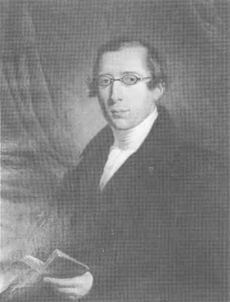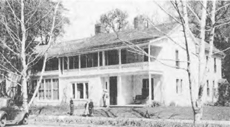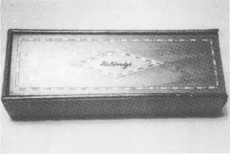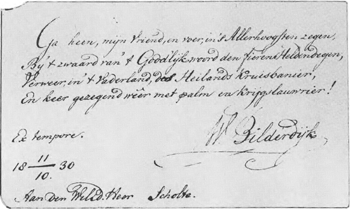Het Bilderdijk-Museum. Jaargang 6
(1989)– [tijdschrift] Bilderdijk-Museum, Het–Willem Bilderdijk west of the Mississippi:
| |
[pagina 13]
| |
 H.P. Scholte as a young man. Scholte house. Photo courtesy of The American Folklife Center, United States Library of Congress.
published west of the Mississippi (a work that Bilderdijk would scarcely have authored), Scholte signed the piece with the by-line ‘An Adopted Citizen’Ga naar eind7.. Even when he wrote in Dutch, e.g. in his messianic (and short-lived) periodical De Toekomst, Scholte warned against any feelings that a Christian soul might enjoy special benefit because of national origin: ‘in Christus is niet Dutch, German or American [sic]’Ga naar eind8.. All this, however, bypasses the unusual and manyfaceted evidence from Pella for the livelong esteem accorded by Scholte to his beloved master. When Scholte arrived in America, he brought with him a variety of Bilderdijk memorabilia. To this day, visitors touring Scholte's near-palatial residence (by standards of the time) are shown the wooden penbox (80 × 225 × 55 mm) with the name Bilderdyk in inlaid work, that remained on the preacher's desk as long as he lived. Though we do not know the exact history of the penbox, it appears to have been made expressly for Bilderdijk (the inscribed name is clearly part of the original workmanship of the piece), and may well have been presented by the family of the deceased poet to Scholte. In a sense, the mantle of the poet may have come to rest upon the shoulders of Da Costa, but the pen - or at least the penbox - passed into the hands of Hendrik Pieter Scholte! It is intriguing to browse Scholte's library, where one finds a first edition of Bilderdijk's various works in near-mint condition. Here one encounters a variety of highly personal reminders of Scholte's abiding affection for his mentor, such as a separate copy of the engraving by Velijn. This personal copy of the print has been trimmed down a bit in size and perforated at the top by a number of pinholes, suggesting that Scholte may at various times have tacked the picture to his wall for memory's (and inspiration's?) sakeGa naar eind9.. Still more personal is the November 10, 1830 albumleaf (88 × 150 mm). Bilderdijk, who composed the poem on the occasion of Scholte's call to military service, certainly seemed to have understood already in 1830 that his young protegé harbored those impulses that would one day send him forth into the American Midwest, brandishing the sword of faith, though never - in contrast to hopes expressed here - to return to the European fatherlandGa naar eind10.. Scholte also possessed manuscript material of possible interest to scholars concerned with the development of Bilderdijk's style. Bound into the collection of miscellanea published in 1804, preceding the first stanza of the printed version, is the corrected manuscript of the historical romance ‘Graaf Floris de Vierde’Ga naar eind11.. On loose sheets tucked inside the same volume (though first found by the investigator in the 1809 Pestel) is the draft, with manuscript corrections, of a poem dated 1804, ‘Op den Moord des Hertogs van Adinghen’ [later: Enghien]. Unfortunately, the permeation of ink into the manuscript leaves makes it extrordinarily difficult to recover the original version of particular lines. Nevertheless, evidence for the process of correction abounds. In ‘Graaf Floris de Vierde’, for example (where recovering the original text often presents special challenges), we note that in at least one instance Bilderdijk simply rearranged words within a poetic line by using small superscript numbers to indicate the desired sequence. In ‘Op den Moord des Hertogs van Adinghen’, one can point to the evolution of several reworked passages, e.g. ‘glorie niet in bloed gebouwd’ to ‘glorie niet op 't zwaard gebouwd’, ‘Europa was beschoren’ to ‘Europa stond beschoren’, ‘In hem is Cesars Geest te ontmoeten’ to ‘Een Cesar zij in hem te ontmoeten’, etc. It is a pity that some of the more extensive corrections cannot be fully analyzed without special technical procedures not available to the investigator. It would be instructive to reconstruct the series of variations that led to the long closing line ‘Wij sterven zo 't moet zijn, maar in de naam van God’, where it is abundantly evident that the poet tried several possibilities before deciding on the one with ‘in de naam van God’ as the final phrase of the poem! It would appear that Scholte also held Katherina Wilhelmina (Schweickhardt) Bilderdijk in particular regard. To the left of his desk is a fine piece of needlecraft reported to have been her handiwork. The Scholte house c. 1930.
| |
[pagina 14]
| |
 The Bilderdijk penbox on display at the Scholte house.
Bound into the posthumous collection of her lyric works, preserved in fine tooled leather bindings that match the volumes of her husband, are the manuscript of a poem ‘Aan mijnen Echtgenoot’ (dated ‘Leyden, in Louwmaand 1809’) and the facsimile of ‘Aan Mevrouw Kemper’Ga naar eind12.. The last item to be noted in the Scholte holdings is an envelope containing small fragments of various dimensions, clipped from what evidently was once a more extensive collection of notes in sheets approximately 150 × 140 mm (with considerable variation). One of the smaller snippets bears the inscription: ‘Excerpten door mij genomen... Brieven van Bilderdijk aan Dacosta [sic]’. These fragments, variously dated in the early 1820's and with page citations from Messchert's 1837 edition, appear to be notes taken by Scholte (recopied by another hand at a later date). As such, they afford insights into the developing personality and outlook of H.P. Scholte. Not so very surprisingly, one encounters a number of statements dealing with the glorious, victorious  Bilderdijk's inscription in Scholte's album.
and Messianic age that commanded so much of Scholte's attention throughout his lifetime, e.g., ‘Dit is de dispensatie des Almachtigen, die wij in ieder overgang van de nacht tot den dag waarnemen, en die Hij ook in de verspreiding der Waarheid door deze nevelen van verblindheid betoont’ (Messchert, 69). The realization of all this, however, presupposes a valiant battle by the faithful: ‘Ja, het is zoo, ons leven is een gedurige stryd en worsteling en ieder oogenblik moeten wy sidderen daarin te bezwyken. Dit is de staat des Christens hier op aarde, in 't midden van de eindelooze aanvechtingen van wereld en boozen geest, en boven al van onze eigene zwakheid’ (Messchert, 106). The battle, however, goes not to those who are mighty in human valor, but rather to those who groan at their own human limitations and rely upon the Lord: ‘Het zijn onze daden niet, het is de zucht des harten waaruit zy voortvloeijen, die kracht heeft, en die zucht is van God’ (Messchert, 65). There also seems to be a thematic clustering on the idea (also expressed in a number of writings composed in America) that suffering, rather than a sign of the Lord's displeasure, is to be taken as evidence of His having chosen the individual for a special blessing: ‘doch, myn vriend, wy ken[nen] ook 't lyden als weldaad onzes Hemelschen Vaders en mogen er voor danken; en dit is zaligheid!’ (Messchert, 54). Often misunderstood in later years, Scholte may well have drawn upon the experience and inspiration of his more youthful encounters with Bilderdijk and his circle of disciples for the strength needed to face what at times may well have seemed to be ‘eindelooze aanvechtingen’. Bilderdijk would certainly have wished nothing more than that he might have inspired Scholte to continuing steadfastness.
Philip E. Webber Central College, Pella, Iowa USA |
|

